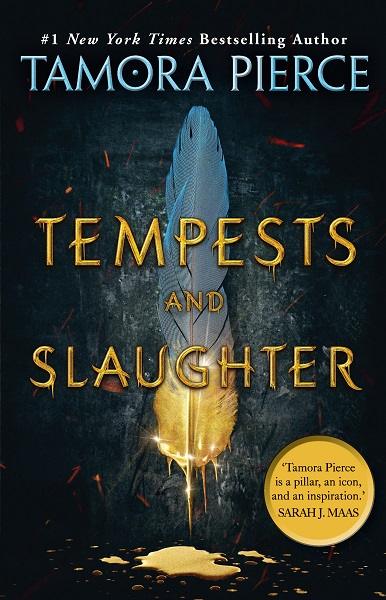Tamora Pierce, Tempests and Slaughter (The Numair Chronicles #1), Hachette, 13 Feb 2018, 480pp., $19.99 (pbk), ISBN: 9780734418678
Arram is a brilliant young boy studying magecraft, soaking up learning and moving faster than his teachers can keep up with him. As he grows older and finds friends who can meet him on his own intellectual level, and teachers who can understand and challenge him as he needs, he also finds himself witness to the political machinations behind the throne of Carthak, and to the bloodthirsty gladiatorial games that keep the empire entertained.
Arram walks the line between seeing too much, caring too much, and being too close to someone who is standing in the rapidly shrinking line to inherit the throne. It doesn’t help that his staggering talent and intelligence, and occasional impatience with slower minds, has made him a few enemies. He may be brilliant, but he’s still only young, and any false step could be fatal.
Fans of Tamora Pierce – and there are many of us – will know that Arram is destined to become Numair Salmalin, a recurring character who has played a significant role in the events of Pierce’s many Tortallan stories, but this should not stop anyone discovering Pierce’s books for the first time. Pierce tips the odd wink or two if you are already familiar with her books, but Tempests and Slaughter stands without prior knowledge.
While this book is a complete story, there is a definite sense that Tempests and Slaughter is laying the groundwork for the rest of the series to come.
One of Pierce’s greatest strengths as a writer is a solid and evocative sense of world-building, and Arram’s world feels very real. His adventures take him not just through the halls of the School for Mages, and the waters where the god of crocodiles lurks, but also into the thick of plague-doctoring and the nastiness of the gladiatorial slave pits at the Imperial Coliseum. Pierce does not hold back on describing the grittier side of the medievalesque world that she builds.
The financial and cultural empire of Carthak is still founded on slavery. Seeing the horrors of slavery played out in the coliseum battles is where Tempests and Slaughter begins, and this is what Arram’s story returns to throughout the book. This book lays the groundwork of Arram’s reaction to the slaughter of the title, alongside the tempests of the imperial line of inheritance. It would also make for some interesting debate to discuss the moral clarity that Arram develops, and the reasons that various characters present for why slavery and gladiatorial fights still happen within this society. Comparing Carthak to the history of Rome and other empires of the ancient world would also be an interesting point of discussion.
Just as Pierce builds worlds that feel solid and real, she also creates characters that I always want to spend time with. Arram himself is interestingly intelligent, with just a hint of impatient arrogance born of constantly dealing with people who just can’t keep up with his mind and talents. He has a strong core of integrity, though, and there is a definite sense that this integrity will be challenged in the future.
Pierce also doesn’t pull any punches as her protagonist goes through adolescence, from the unpredictability of the teenage body and unexpected erections, to the emotional complications and upheavals of romantic feelings.
The ancillary characters of Ozorne and Varice are also deeply interesting and fascinatingly flawed, and I like the friendship that Pierce has built between the three characters. Pierce writes a diversity of characters of colour, cultural difference and sexual orientation without ever making a big deal of it. While Pierce doesn’t blink at the problems and bigotry of this world which are reflected in some ways in the world of Carthak, she plants her protagonist very firmly on the side of acceptance and justice, and in this book Arram is already using the tools at his disposal to fight for that justice.
Pierce’s writing is skilled, and evokes a strong sense of both the environment and the people that Arram deals with, and the feelings that he goes through. Tempests and Slaughter is not for the faint of heart, and I would slate it for readers 15 years and up, but it is worth stepping into the mud and chaos with Arram, and it is a book to stay with readers long after they’ve closed the last page.
Reviewed by Emily Clarke


